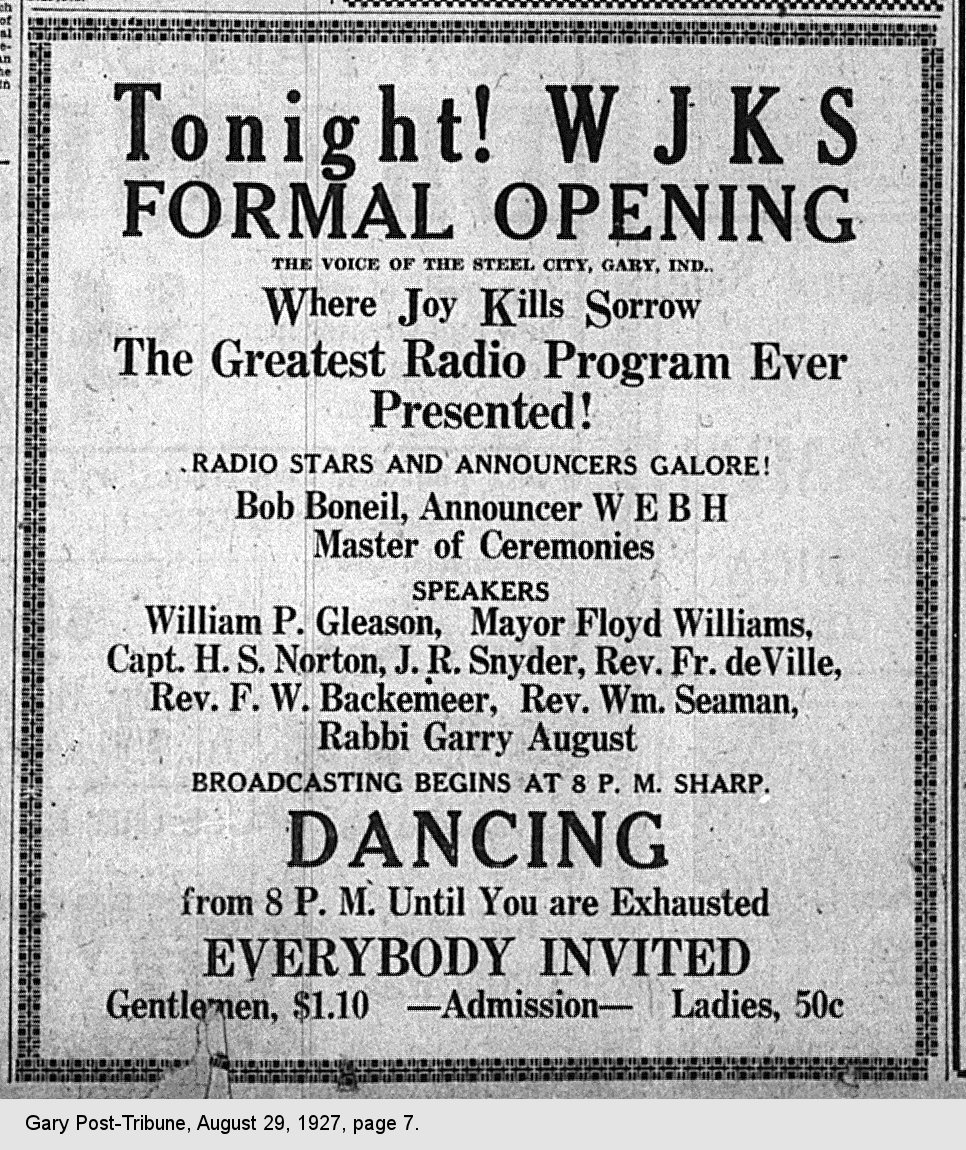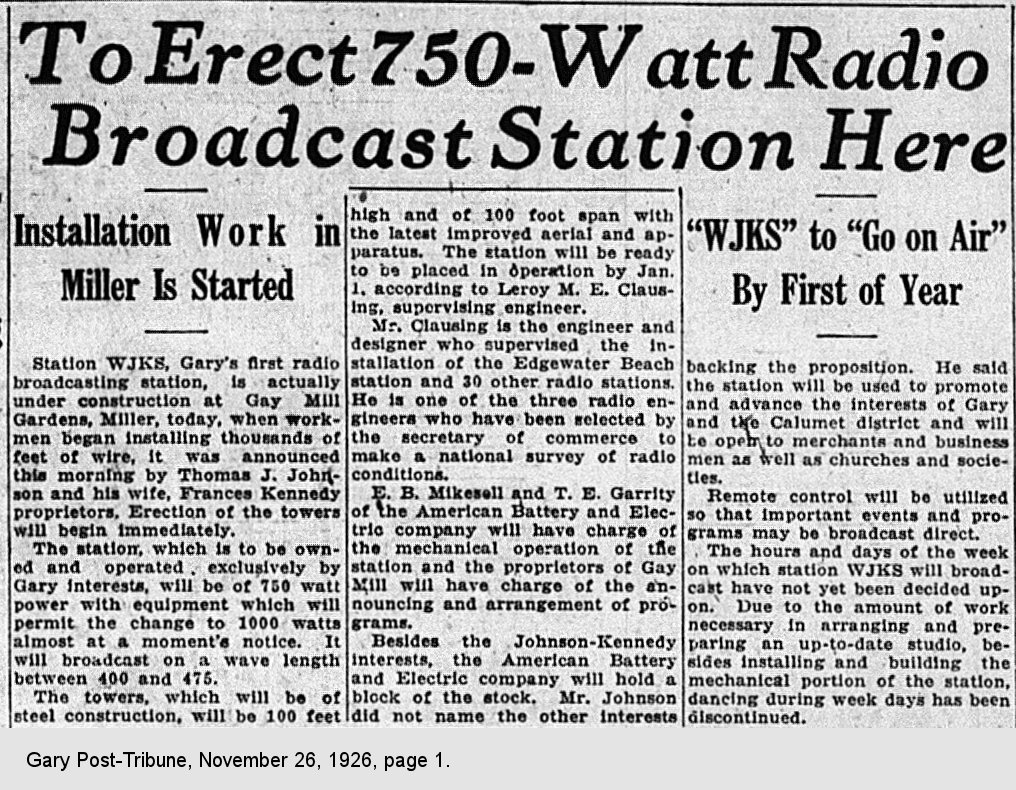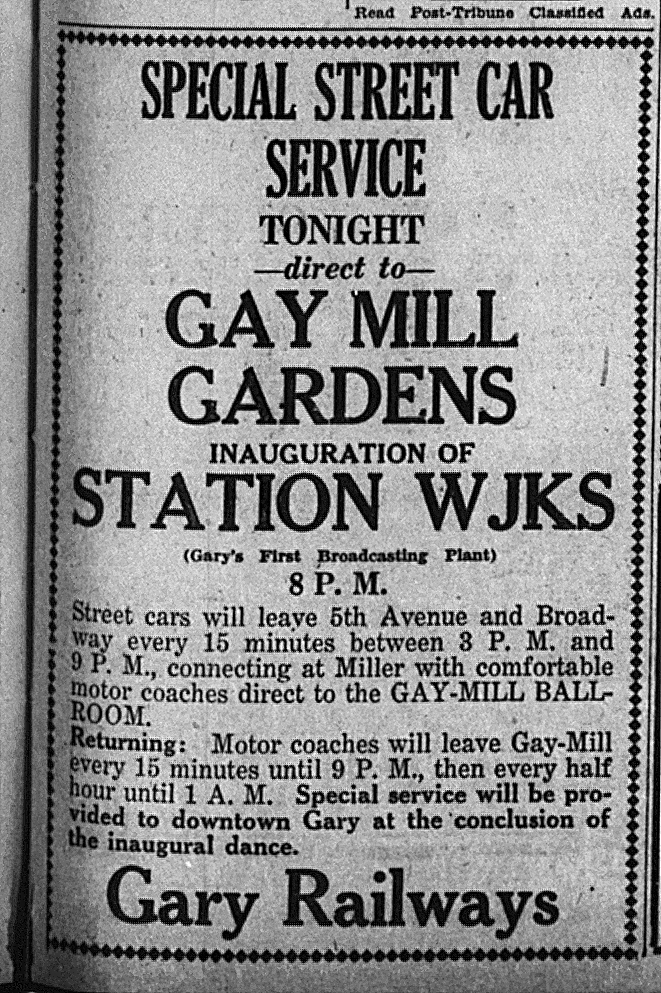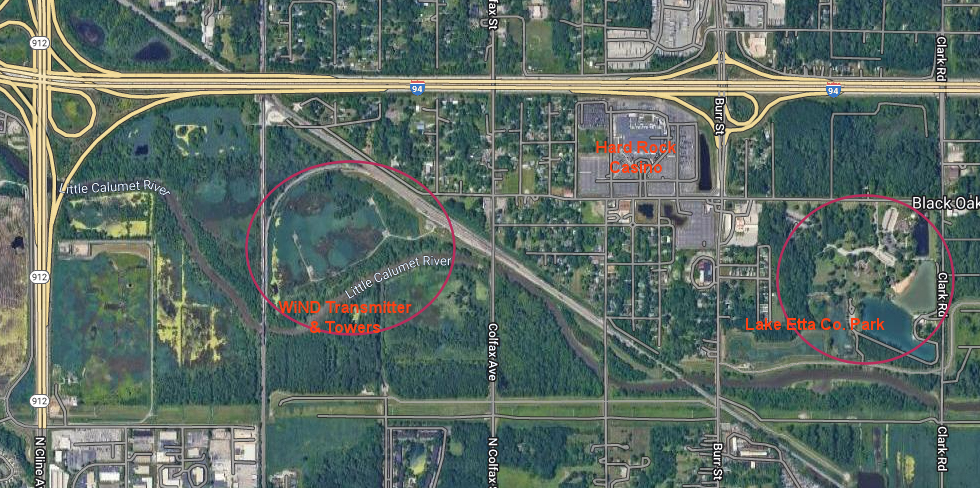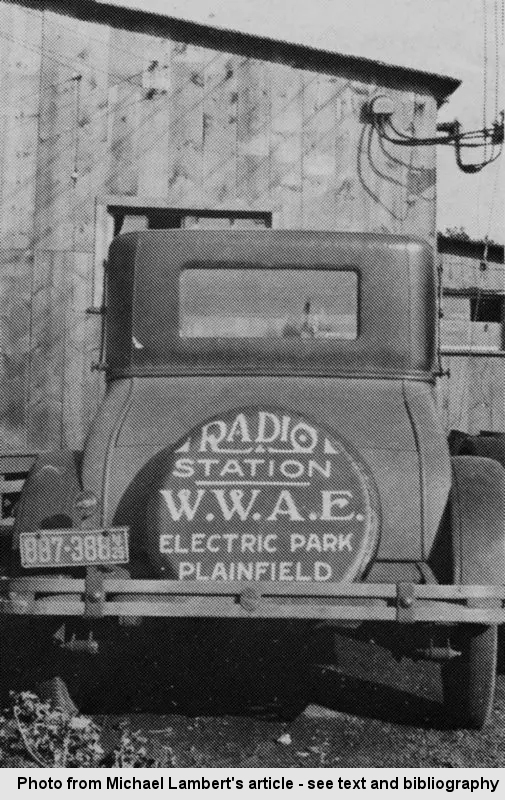Miller - The Site of the Region's First* Radio Station
WJKS - "Where Joy Kills Sorrow"
Monday night on the 29th of August in 1927 was a big night in Miller.
Dozens of folks in evening attire converged with others on Gay Mill for the first broadcast of a radio program from Northwest Indiana.
* "First" - while WWAE (WJOB) was licensed in 1923, it did not begin transmitting from Hammond until some eleven months after WJKS (WIND) began transmitting from Gay Mill in Miller. I’ve used “transmit” or “transmitter” to mean the actual electronics and tower that sends radio waves into the air, “broadcast” to mean the content of what is transmitted; two different things sometimes and often in two different places. WJKS / WIND is Northwest Indiana’s oldest, continuous radio station, broadcasting and transmitting from Gay Mill initially.
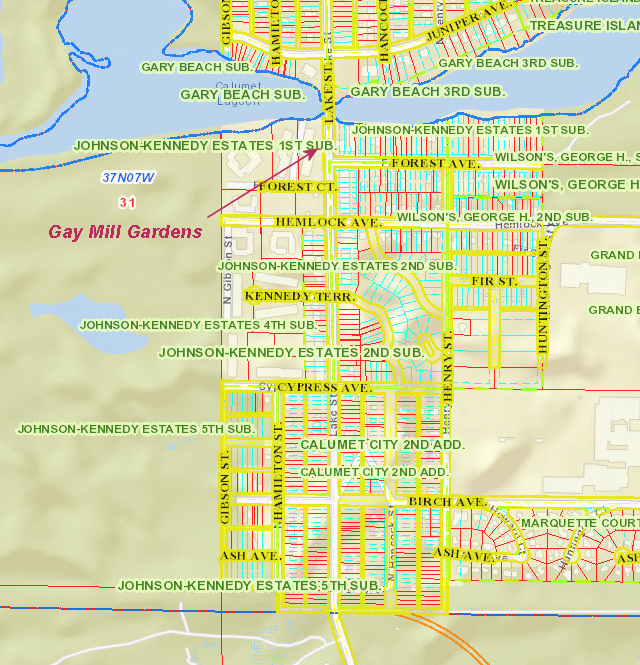
The station was located at Gay Mill which was on west side of North Lake Street just south of the river. The land is now occupied by apartment buildings.
Finally, after months of wrangling following the construction of the studio and 100-foot tower completed in March, the license was intact and the switches could be thrown to broadcast on 1290-AM at 500 watts of power. Celebrities from the Mayor to local talent were there to launch “Where Joy Kills Sorrow” – station WJKS. Special Street cars were arranged to leave 5th Avenue and Broadway to carry folks to Gay Mill and special coaches to carry them back following the inaugural dance. A Spanish baritone, 32-year-old Fortunio Bonanova, on his way to Hollywood, sang, (Footnote: Bonanova would appear in 103 films, including Citizen Kane, Double Indemnity, and For Whom the Bell Tolls. His extent of work is at The Internet Movie Database His Wikipedia article has a good biography. ) as did the Strom Sisters, three young ladies who lived on East Sixth Place in Miller. (Footnote: The Strom Sisters- While there is no direct naming of them, they must have been Esther, Edith, and Ellen Strom, the daughters of Charles and Emma Strom who lived at 6100 E. Sixth Place in Miller. Esther, who had married Robert Pearson in 1922, would continue to live on East Sixth Place as a school teacher and in 1970 wrote a history of Miller which became the standard, accepted, History of Miller. Anyone wishing a copy of that, contact me. A portion of it is on my webpage “How Miller Got Its Name” and another portion on the page on Gay Mill -“Personal Remembrances” towards the end of GayMill.aspx. ) Other local talent included pianist Bessie Franson who lived on what is now E. 5th Place in Miller, and Martha Amlong, a Hobart High School student. The full list of musical numbers is in the image from the Post-Tribune.
Sandwiched with the musical entertainment were speeches by a number of people. The next day the Post-Tribune published Superintendent Gleason’s 25-minute speech in toto, prefacing it with “The masterful address of William P. Gleason…portraying to a radio audience the wonderful story of Gary’s 21 years of growth, progress and expansion…is the best narrative of its kind ever written about the “Steel City.” (Footnote: “W.P. Gleason Paints Masterful Word Picture of Gary’s 21 Years of Progress”, Gary Post-Tribune, 30 August 1927, page 1 & 2. ) Tom Johnson and his wife, Frances Kennedy, owners of Gay Mill and WJKS, presented the station to the city “to use for the purpose of developing the character of our men and women and to make them better citizens of the state and country.” (Footnote: “WJKS Presented to City of Gary By Thomas J. Johnson Last Night”, Gary Post-Tribune, 30 August 1927, page 2. ) The Post-Tribune published also his address complete. Almost all the first three pages of Tuesday’s Post-Tribune were devoted to inaugural broadcast.
The summer of 1927 must have been very frustrating for Tom and Frances, the owners of Gay Mill and builders of the radio station. Two days after the application for a license was filed February 21, President Coolidge signed the Radio Act of 1927 aimed at clearing up the “radio chaos” that existed in America; stations had been fighting for air wave in intense competition. Johnson, accompanied by his son, appeared before Radio Commission on August 3 to plea for their license, which was opposed by WWAE and WSBC, Chicago stations; WWAE would later become WJOB in Hammond, but more about that later.
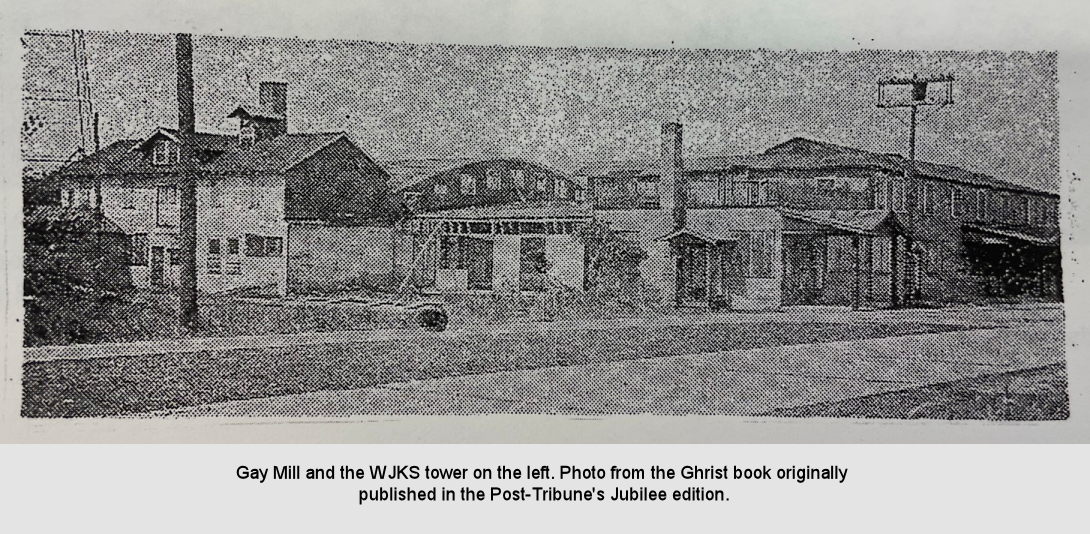
The license was finally issued on August 15, 1927 to operate on 1290 at 500 watts, sharing time with Chicago station WSBC. All which led to the big event of the first broadcast on the 29th. While Bob Boniel (Footnote: Boniel: They spelled his name wrong on the ad: he was Robert David Boniel – per his WWII draft card, Ancestry.com records and Chicago Tribune articles. Boniel was station manager of WEBH, a small station in the Edgewater Beach Hotel who went to WTMJ in Milwaukee in 1929. ) was announced as the Master of Ceremonies for the inaugural broadcast, the comedienne/singer/owner Frances Kennedy was likely the “life of the party.” She broadcast in the following weeks becoming the popular “Voice of the Steel City” to the point that when she left for her winter vaudeville tour at the end of September, the Hammond Times noted on page one that she would be missed. (Footnote: Times Sept 28, 1927, page 15. https://www.newspapers.com/image/304639131/ “Radio fans heard the voice of Miss Frances Kennedy for the last time in several months from Station WJKS, one of the owners last night when the program dedicated in her honor, as she bids a temporary farewell, leaving today on her annual winter vaudeville tour." )
It appears that Tom and Frances had a sincere desire to make “The Voice of the Steel City” a community station; on September 3, 1927 they launched a “Children’s Hour” – actually an afternoon – to become a stimulus to Gary children in their study of arts and music. They invited Gary artists to try out at WJKS if they had ambitions to become radio stars or entertainers. (Footnote: “WJKS Gives First Hours To Children”, Gary Post-Tribune, 2 September 1927, page 18. ) While Frances toured her vaudeville act in the winter, the station continued to broadcast the dances from Gay Mill. In November of 1929 WJKS wanted to broadcast the Horace Mann-Emerson football game at Gleason field and installed special wiring to do so. At the last-minute school officials decided that Johnson couldn’t do so, claiming that it would cut down attendance. Tom was incensed, as was Superintendent Gleason and a great number of other Gary people. (Footnote: Football game broadcast: “WJKS Receives Many Protests,” Hammond Times, Nov 4, 1929, page 17. While Johnson received the protests, they were ultimately directed at the school officials. People wanted to hear the game broadcast. )
That was the ‘heyday’ of WJKS and Gay Mill. Madura’s Danceland opened in October of 1929, no doubt drawing away dancers and party goers. WWAE began broadcasting from Hammond in July of 1928. WJKS’ frequency was changed on November 11, 1928 to 1360 on 1KW of power and then finally to 560 on 1 1/4KW on October 16, 1931. That raised a series of conflicts for several years and finally settled at 560 on 1KW. Transfer of the License from the Johnson-Kennedy Radio Corporation to Westinghouse Broadcasting Company occurred in 1953. (Footnote: History Cards - WJKS (see bibliography) )
WJKS > WIND

In 1932 it was time to move out of Gay Mill however. The studio moved to East 8th Street in Gary and then to 504 Broadway in Gary (Footnote: History Card - WJKS, Card No. 1 – “Main Studio Location” ) where it remained until 1944, by then broadcasting with the call sign WIND. Gleason Field on June 17, 1933 was the scene of a preview of “Gary Day”, June 29th, at the Chicago World’s Fair Century of Progress. The day before, WJKS’ call sign had been changed to WIND and it had joined the Columbia Broadcasting system. A 45-minute section of the festival program was broadcast nationwide through this connection with CBS. (Footnote: Call sign change: “1800 Take Part in Gary Fair Spectacle Tonight”, Gary Post-Tribune, 17 June 1933, pages 1 & 2. )
The transmitter remained in Miller until 1933 when it moved to where Lake Etta Park County Park is today (4801 W. 29th in Gary) and power was increased. (Footnote: History Card - WJKS, image 21. ) Evidently it was in the 1970s when the transmitter was moved about a mile west to where the four towers rise today, on the border of Gary in Griffith, on the banks of the Little Calumet River. (Footnote: History Card - WJKS; also File BL-14, 374 FCC Standard Broadcast Station License Alternate Transmitters dated December 1, 1979 locates the transmitter at 3000 N. Colfax St., Griffith, Indiana. )
WWAE > WJOB
While WJKS was the first radio station to broadcast from Northwest Indiana, close on its heels was WWAE, the predecessor of WJOB, which had been licensed in 1923 broadcasting from Chicago. Station ‘clutter’ in the 1920s forced its move to Plainfield, Illinois, then to Joliet, back to Chicago, and finally to Hammond. (Footnote: History Card – WWAE, image 2, 20 and 21. Apparently, the station’s transmitter was always in Chicago until it moved to Hammond. ) By May 21, 1928 the tower and transmitter were ready to be tested in Hammond, but licensing problems delayed the first official broadcast until July 6, 1928, a regular bill of programs starting eleven days later. (Footnote: “Hammond Will Soon Have Radio Broadcast Station in Operation – To Build Towers at Douglas Park Site”, The Times, 9 May 1928, page 13; “Hammond Radio Station Ready Soon”, The Times, 21 May 1928, page 11. ) There were still licensing problems that forced the station’s owner, Dr. George Courier, to appear before the Federal Radio Commission on the 18th to argue for the continuation of WWAE’s license, which was being considered for non-renewal. (Footnote: WWAE was on a list of 162 stations losing their license published in the Gary Evening News on May 28, 1928. The Federal Radio Commission was to drastically clear the ether of interference; 18 July 1928 Hammond Times page 1: “WWAE Before Commission” “Dr. Geo. Courier, a Methodist minister, appeared before the federal radio commission today to argue for the continuation of station WWAE at Hammond, Ind. He explained that the Anti-Saloon League and other reform organizations have first call on its time, and that the station has a contract with the Anti-Saloon League which provides $3,000 a year revenue.” )
Curiously, the station was initially licensed by a notorious Joliet bootlegger, Lawrence “Butch” Crowley, who broadcast from the Alamo Dance in Joliet, hoping to increase traffic to the dance hall. When Crowley got into trouble with the IRS during prohibition and went broke, the license transferred to a Methodist minister, the Rev. George Courier who claimed at his hearing before the Radio Commission in 1928 that he was supported by the Anti-Saloon League.
Perhaps the best description of the early days of WWAE in Joliet is a local historian’s contribution to The Patch – an online community network. Michael Lambert’s article, “Electric Park – Wild Days of Jazz, Booze, and A Preacher". WJOB has a “History of Radio Station WJOB” at its website which isn’t entirely accurate for the early days.
Other Stations in Northwest Indiana in the 1920s
WJKS and WWAE were not the only stations operating in Northwest Indiana in the 1920s. Two other stations, very short lived, were licensed. WRBC – “World Redeemed by Christ” – was owned by Immanuel Lutheran church in Valparaiso and broadcast from March 25, 1925 to March of 1929, its license cancelled in April of 1930. In 1925 the station, with 500 watts of power reaching about a hundred miles, was on the air two days a week with Sunday services and musical and educational programs on Monday.
Another short-lived station was WLBT – “Where Lovers Become Tied” – operated out of Crown Point from 1926 to August 1, 1928 when its license expired. Put together by radio enthusiast Bud Wendel from spare and home-made parts attached to windmill towers it broadcast at 100 watts of power news, public service programs, and music. The call sign reflected Crown Point’s reputation as a “marriage mill,” where couples from outside Indiana could come to get married as Indiana had no marriage laws governing anything, least of all a waiting period.
There is more detail on both stations in John Ghrist’s hard to find book, Valley Voices – A History of Radio Broadcasting in Northern Illinois and Northwest Indiana from 1910-1992, pages 101-103. (See the Bibliography below.)
Bibliography
Links open in a new window or tab.
- Newspaper articles are referenced in the footnotes. Captured from newspapers.com or from the microfilm of the Gary Post-Tribune at the Lake County Library. Contact me if you would like to see the full article/reference.
History Cards
“History Cards were first used by the Department of Commerce to keep track of applications filed by, and changes to, the earliest AM broadcast stations in the early 1920s. The records were subsequently transferred to the Federal Radio Commission in 1927, and after that to the Federal Communications Commission when that agency was created in 1934. These cards gradually grew into a large card file. History Cards remained in use until the creation of the first computerized database in 1980 to track broadcast applications, the Broadcast Application Processing System (BAPS). However, the Commission did not transfer the data from the History Cards to the new system. Instead, it retained the History Cards in their original form – 3” by 5” filing cards – for reference.” (From “About the History Cards” at the end of every History Card file.)
The History Cards were photographed and the images put into a single PDF which are housed by the FCC and accessible through Fccdata.org. These are rather large files. Current AM station information can be found through a search at https://www.fcc.gov/media/radio/am-query
- History Card-WJKS. At Fccdata.org search WIND in the "Call Sign." Direct link to the History Card is https://licensing.fcc.gov/cgi-bin/prod/cdbs/forms/prod/getimportletter_exh.cgi?import_letter_id=60831&.pdf (48 images in the PDF; 33 MB downloaded).
The first History Card for WJKS / WIND - note top left, "Date First Licensed" and top right date and Call Letters.
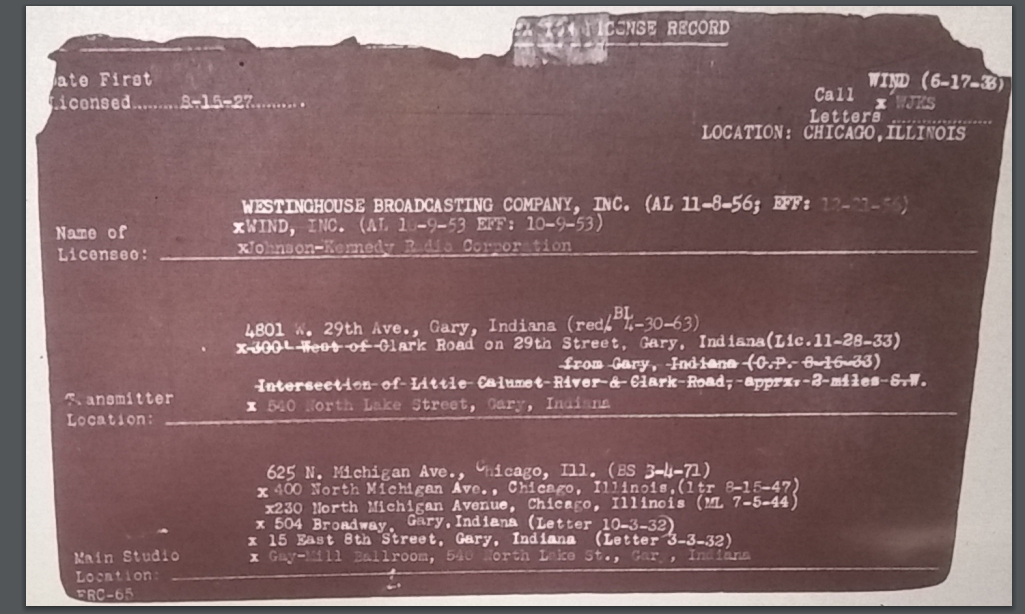
- History Card-WWAE. At Fccdata.org search WJOB in the "Call Sign." Direct link is https://licensing.fcc.gov/cgi-bin/prod/cdbs/forms/prod/getimportletter_exh.cgi?import_letter_id=61446 (51 images in the PDF; 35 MB downloaded).
- GHRIST, John Russell. Valley voices: a history of radio broadcasting in Northern Illinois and Northwest Indiana from 1910-1992. [1992, West Dundee, IL] (P.O. Box 1073, West Dundee 60118). Spiral binding of many pages. WorldCat Listing: http://www.worldcat.org/oclc/27744618 Contact me if you'd like any images of relevant pages.
- Lambert, Michael, “Electric Park – Wild Days of Jazz, Booze and A Preacher Man.” An excellent history of the early days of WWAE referenced in the text above. Part of a four-part series by local historian Michael Lambert published in The Patch. For the other articles on Electric Park’s history by Mr. Lambert scroll down on the listings of his articles in The Patch: https://patch.com/users/michael-lambert-a584fe32/articles
- Wikipedia articles of some use
- WIND-AM / WJKS: https://en.wikipedia.org/wiki/WIND_(AM)
- WJOB-AM / WWAE: https://en.wikipedia.org/wiki/WJOB_(AM)
- See the Miller History Table of Contents on this website for additional information on Gay Mill, Frances Kennedy, and Thomas Johnson:
- “The Roaring Twenties Come To Miller Beach” - http://spicerweb.org/Miller/MillerHistory/GayMill.aspx
- “Frances Kennedy - the Merriest Comedienne” - http://spicerweb.org/Miller/MillerHistory/KennedyJohnson.aspx
- “The Musical Comedies of Frances Kennedy” - http://spicerweb.org/Miller/MillerHistory/JK/Musicals/Musicals.aspx
